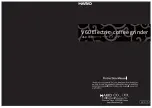
7
en
Safety warnings specific for sanding
operations
Do not use excessively oversized sanding disc
paper. Follow manufacturers recommenda-
tions, when selecting sanding paper.
Larger
sanding paper extending beyond the sanding
pad presents a laceration hazard and may
cause snagging, tearing of the disc, or kick-
back.
Safety warnings specific for wire
brushing operations
Be aware that wire bristles are thrown by the
brush even during ordinary operation. Do not
overstress the wires by applying excessive
load to the brush.
The wire bristles can easily
penetrate light clothing and/or skin.
If the use of a guard is recommended for wire
brushing, do not allow any interference of the
wire wheel or brush with the guard.
Wire
wheel or brush may expand in diameter due
to work load and centrifugal forces.
Further safety warnings
Use elastic spacers/liners when these are
provided with the grinding accessory.
Make sure that the application tools are
mounted in accordance with the manufactur-
ers instructions. The mounted application
tools must be able to rotate freely.
Incorrectly
mounted application tools can become loose
during operation and be thrown from the
machine.
Handle grinding accessories carefully and
store them according to the manufacturer’s
instructions.
Damaged grinding accessories
can develop cracks and burst during opera-
tion.
When using application tools with a threaded
insert, take care that the thread in the appli-
cation tool is long enough to hold the spindle
length of the power tool. The thread in the
application tool must match the thread on the
spindle.
Incorrectly mounted application
tools can loosen during operation and cause
injuries.
Beware of any concealed electric cables, gas
or water conduits.
Check the working area
before commencing work, e.g. with a metal
detector.
Use a stationary extraction system, blow out
ventilation slots frequently and connect a
residual current device (RCD) on the line side.
When working metal under extreme operat-
ing conditions, it is possible for conductive
dust to settle in the interior of the power
tool. The total insulation of the power tool
can be impaired.
This double-insulated power tool is equipped
with a polarized plug (one contact is wider
than the other). The plug will only fit into the
polarized socket outlet in one position. Turn
the plug if it does not fit completely into the
socket outlet. If the plug still does not fit, have
a qualified electrician install a polarized
socket outlet. Do not modify or alter the plug
under any circumstances.
Double-insulated
power tools neither require a three-core
mains cable nor a mains connection with
ground contact.
Operate the power tool only off power sup-
plies whose voltage and frequency values
correspond with the values on the type plate
of the power tool.
If operating the power tool in a damp location,
it must be connected via a ground-fault cir-
cuit interrupter (GFCI).
Using special rubber
protective gloves and footwear increase your
own safety.
NOTE:
Such a device is also known as ground
fault circuit interrupter (GFCI) or earth leak-
age circuit breaker (ELCB).
Do not rivet or screw any name-plates or
signs onto the power tool.
If the insulation is
damaged, protection against an electric shock
will be ineffective. Adhesive labels are recom-
mended.
Always work with the auxiliary handle.
The
auxiliary handle ensures reliable guiding of
the power tool.
Before putting into operation, check the
power connection and the power plug for
damage.
Recommendation: The tool should always be
supplied with power via a residual current
device (RCD) with a rated current of 30 mA or
less.
OBJ_BUCH-0000000073-001.book Page 7 Wednesday, May 30, 2012 3:17 PM








































